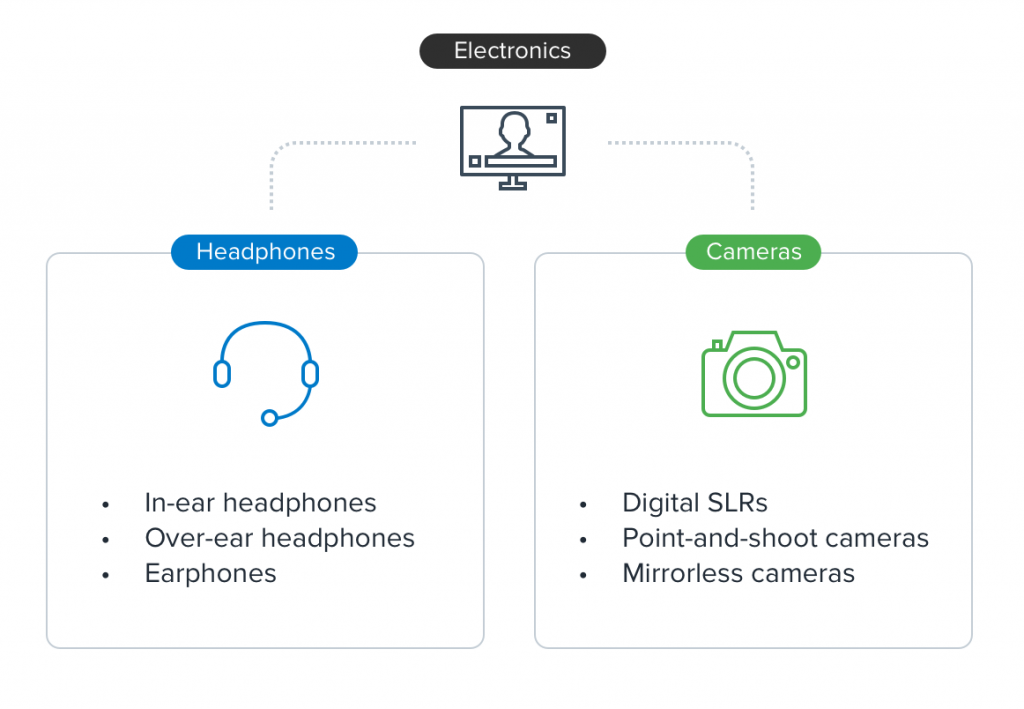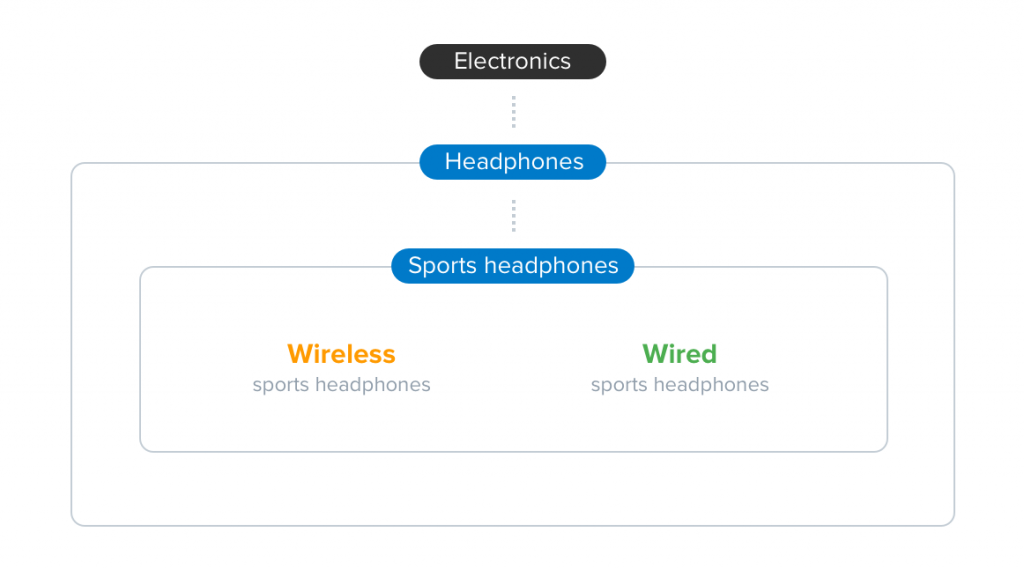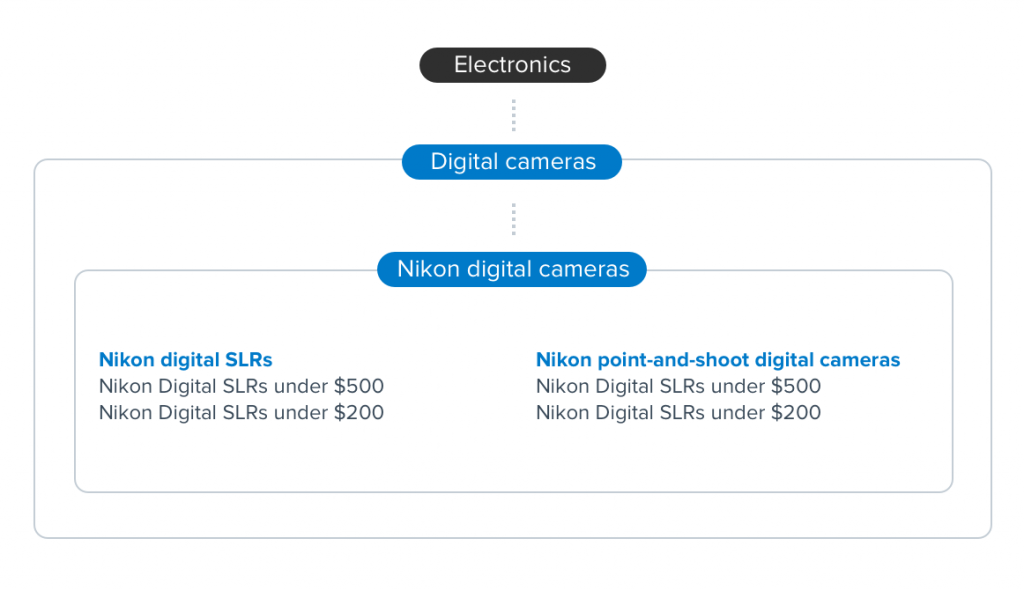Ecwid Starter 플랜으로 최대 10개의 아이템을 판매한다면, 간단히 제품을 매장에 올려놓고 판매를 시작하는 것만으로도 충분할 수 있습니다.
더 크거나 향후 확장 가능한 제품 카탈로그의 경우 먼저 몇 가지 계획을 세워야 합니다. 모든 건물이 건축 계획으로 시작하는 것처럼, 제품 카탈로그에도 이상적으로는 검색이 가능하고 유연성이 있는 구조가 필요합니다.
중요한 이유
모두가 집에 가지고 다니던 그 부피가 큰 인쇄된 카탈로그를 기억하십시오.
이제 모든 것이 온라인으로 이동했습니다. 이제 인쇄된 책을 찾아볼 필요 없이 해당 소매업체의 웹사이트에서 모든 제품을 찾을 수 있습니다.

IKEA의 인쇄된 카탈로그와 온라인 카탈로그
판매 가능한 모든 제품을 선보이는 것이 단지의 유일한 기능은 아닙니다.
아마도 당신은 이런 식으로 생각하지 않았을 것입니다. 그러나 당신의 카탈로그는 성공의 기초이기도 합니다. 옴니 채널 소매. 명확하고 정확한 데이터가 있으면 여러 채널에서 제품을 판매하는 것이 훨씬 쉬워집니다.
웹사이트, Facebook 스토어, Amazon 등 세 가지 채널에서 신발을 판매한다고 가정해 보겠습니다. 각 채널에 동일한 제품 데이터가 있기를 원합니다. 신발 색상이 "검은색"인 경우 "caviar", "onyx" 또는 "dark dark grey"가 아닌 모든 곳에 "black"으로 표기해야 합니다.
따라서 이 글의 조언을 실천에 옮기면 많은 이점을 얻을 수 있습니다.
더 나은 SEO
카탈로그의 모든 데이터 포인트는 고객이 검색 엔진에서 귀하의 제품을 찾을 수 있는 키워드입니다. 데이터가 많을수록 순위를 매길 수 있는 키워드가 많아집니다.
카탈로그에 제품 이름만 있는 경우 고객은 해당 특정 단어를 검색해야만 귀하를 찾을 수 있습니다. 브랜드 이름, 가격, 자세한 제품 설명을 추가하면 고객이 제품을 찾을 수 있는 추가 키워드를 제공할 수 있습니다.

BestBuy는 고객이 검색 엔진에서 제품을 찾는 데 도움이 되도록 자세한 설명, 기술 사양, 리뷰 등을 제공합니다.
더 나은 제품 정보
미국 성인 쇼핑객의 30%는 소매업체가 자세한 제품 정보를 제공하는 경우에만 이전에 쇼핑한 적이 없는 소매업체에서 구매하는 것을 고려할 것입니다.
제품 카탈로그가 없으면 제품 정보의 깊이가 일관되지 않는 경우가 많습니다. 자신의 사이트에는 자세한 데이터가 있지만 마켓플레이스에는 정보가 부족할 수 있습니다.
강력한 카탈로그는 모든 제품 정보를 중앙 집중화하고 쇼핑객이 원하는 것을 원하는 곳에서 쉽게 찾을 수 있도록 해줍니다.
깔끔한 매장관리
제품 카탈로그는 제품 범위를 확장할 수 있는 준비된 템플릿을 제공합니다.
운동화를 판매하는 경우 이미
공급업체 및 유통업체와 더 효율적으로 협력
공급자는 일반적으로 소비자에게 제품을 판매하지 않으므로 강력한 제품 정보 데이터베이스를 유지할 필요성을 느끼지 않습니다. 더 나은 제품 카탈로그 관행을 채택하면 공급업체의 제품 데이터를 더 쉽게 업데이트하고 수정할 수 있습니다. 이를 통해 더 다양한 공급업체와 협력하고 제품을 더 빠르게 시장에 출시할 수 있습니다.
그 반대도 마찬가지입니다. 당신이 노력하고 있다면 귀하의 제품에 대한 유통업체를 찾아보세요, 공급할 수 있는 것
관련 : 모든 Ecwid 매장의 URL 정리: 더 나은 SEO를 위한 간단한 방법
제품 카탈로그를 만드는 방법
제품 카탈로그 아키텍처를 구축하려면 제품 데이터를 수집하고 이를 논리적이고 표준화된 방식으로 구성해야 합니다. 그 중 대부분은 각 제품에 대해 어떤 종류의 데이터를 수집해야 하는지, 향후 정확성과 확장을 위해 데이터를 구성하는 방법을 이해하는 것과 관련됩니다.
프로세스는 아래와 같이 크게 두 단계로 나눌 수 있습니다.
1. 상품 데이터 수집
크기와 무게부터 브랜드, 건축 자재까지 각 제품에 대해 수집할 수 있는 데이터가 방대합니다. 이 데이터가 모두 필요하거나 유용한 것은 아닙니다. 따라서 첫 번째 단계는 어떤 데이터를 수집할지 파악하는 것입니다.
이 프로세스 중에 수집하는 모든 데이터는 세 가지 요구 사항을 충족해야 합니다.
- 고객에게 정확한 제품 정보 제공
- 제품을 더 잘 관리할 수 있도록 도와주세요
- 카테고리의 모든 유사한 제품에 대해 표준화되어야 합니다.
신발을 판매하는 경우 각 신발에 대한 정확한 사이즈 정보가 필요합니다. 그러나 표준 크기(예: 선글라스)로 제품을 판매하는 경우 크기 정보가 필요하지 않을 수 있습니다.
일반적으로 데이터가 너무 적다는 것보다 데이터가 너무 많다는 측면에서 오류를 범하는 것이 더 좋습니다. 이는 고객이 결정을 내리는 데 도움이 될 뿐만 아니라 목록에 추가하면 SEO도 향상됩니다.
각 제품에 대해 두 가지 유형의 데이터를 수집하려고 합니다.
- 일반 데이터: 가격 등 필수 제품 세부정보, SKU, 무게, 치수, 가용성, 재고 수준,
매장별 ID(예: Amazon에서 사용하는 ASIN 번호) 등 제품별 데이터 : 이는 제품마다, 카테고리마다 다릅니다. 예를 들어 청바지를 판매하려면 밑 솔기 길이와 허리 사이즈 정보가 필요합니다. 그러나 TV를 판매하는 경우에는 화면 크기와 해상도 데이터가 필요합니다.
The
무엇인지 알아내는 한 가지 방법

Amazon 목록에는 제품 유형에 따라 다른 데이터 필드가 표시됩니다.
더 아래로 스크롤하면 제품의 크기, 무게, 매장 ID 등을 지정하는 다른 데이터 세트가 표시됩니다. 이는 Amazon의 모든 제품에 대해 찾을 수 있는 "일반" 데이터입니다.

매장의 모든 제품에는 SKU, 가격, 치수와 같은 데이터 포인트가 필요합니다.
당신이 Ecwid라면
Amazon(및 기타 대형 소매업체)을 사용하여 각 제품 및 제품 카테고리에 대해 수집할 데이터를 알아보세요. 최소한 다음이 있어야 합니다.
- 제품명 및 설명
- 가격
- 제품 설명
- SKU 및/또는 제품 ID
- 크기 및 무게
- 제품 키워드
- 제품 카테고리 및 하위 카테고리
- 제품 이미지(기본 이미지 및 대체 보기 사양 포함)
사용자 생성 데이터(리뷰 및 평가)
당신의 입장이 되어보세요 타겟 고객 페르소나. 질문: 이 고객이 구매 결정을 내리려면 어떤 종류의 데이터가 필요합니까?
제품 카탈로그를 의미론적으로 어떻게 구성할지 생각해 보세요. 스튜디오 헤드폰은 "악기", "전자제품" 또는 둘 다에 속합니까? 신발을 '운동화' 아래에 놓나요, 아니면 '운동복' 아래에 놓나요?
일부 제품은 여러 카테고리에 속한다는 것을 알게 될 것입니다. 제품 카탈로그를 생성할 때 이를 지정해야 합니다.
여러 가지 방법이 있습니다 주요 제품 데이터를 자동으로 수집.
첫 번째는 다음과 같은 공개 제품 데이터 소스입니다. 브로케이드. 이러한 웹사이트는 GTIN 분류 시스템 (ISBN과 유사하지만 제품용) 제품과 해당 주요 데이터 속성을 식별합니다.

Р공용 데이터 저장소
공개 데이터 소스의 문제점은 정보가 정확하지 않거나 정기적으로 업데이트되지 않을 수 있다는 것입니다. 이러한 경우에는 다음과 같은 회사에서 제공하는 제품 데이터 API를 사용할 수 있습니다. 데이터피니티 or 색인.
이러한 도구는 원하는 형식으로 원하는 데이터를 얻는 데 도움이 됩니다. 그러면 할 수 있습니다 이 데이터를
세 번째 옵션은 공급업체가 제공한 데이터를 사용하는 것입니다. 다수의 도매업자 및 직송업자 풍부한 제품 데이터를 제공합니다. 이것을 컴퓨터에 연결하기만 하면 됩니다.
2. SEO를 위한 카탈로그 구성
제품 카탈로그의 핵심 목적 중 하나는 귀하의 제품을 개선하는 것입니다. 웹사이트의 SEO. 여기에는 의미상 관련된 키워드를 중심으로 카탈로그를 구축하는 작업이 포함됩니다. 제품 카테고리는 논리적으로 관련성이 있을 뿐만 아니라 고객의 검색 기본 설정과도 일치해야 합니다.
전자제품을 판매하는 경우 논리적으로 제품을 세 가지 수준으로 구성할 수 있습니다.

논리적으로는 타당하지만 이러한 카테고리가 고객이 검색하는 방식을 항상 반영하는 것은 아닙니다. 운동을 위해 헤드폰을 검색하는 운동선수는 다음을 검색하지 않을 수도 있습니다.
이러한 고객을 주로 대상으로 하는 경우 전체 매장 조직은 다음과 같은 키워드 기본 설정을 반영하도록 변경됩니다.

따라서 귀하의 목표는 논리적이고 논리적인 방식으로 제품을 구성하는 것이어야 합니다.
타겟 키워드를 살펴보고 "광범위"에서 "좁은" 순으로 정리하세요. 디지털 카메라를 판매하는 경우 다음과 같은 키워드 구성을 사용할 수 있습니다.

키워드 도구를 사용하는 대신 경쟁업체에 문의할 수도 있습니다. 성공적인 소매업체, 웹사이트, 블로그 등이 제품을 어떻게 구성했는지 살펴보세요. 그들은 어떤 키워드를 타겟팅하고 있습니까? 키워드는 서로 어떻게 연관되어 있나요?
이 연습의 목적은 제품을 다음과 같은 방식으로 구성하는 데 도움을 주는 것입니다.
3. 제품 카탈로그 만들기
제품 카탈로그를 생성하는 데는 네 가지 옵션이 있습니다.
- 엑셀 : Excel 스프레드시트로 제품 카탈로그를 만듭니다. 그러면 할 수 있습니다 그것을 당신의
전자 상거래 소프트웨어 CSV 파일로 저장하여 큰 스프레드시트를 관리하는 것은 어려울 수 있습니다. - 데이터 베이스: 사용자 정의 데이터베이스(SQL, MongoDB 등)를 사용하여 제품 카탈로그를 생성하십시오. 이 데이터베이스를
전자 상거래 제품을 수입하는 소프트웨어. 이 접근 방식은 빠르기는 하지만 기술적으로 복잡합니다. - PIM: Akneo와 같은 전용 제품 정보 관리(PIM) 시스템은 상세한 제품 카탈로그를 생성하는 데 도움이 됩니다. 그러나 모든 PIM이 기존 PIM에 연결되는 것은 아닙니다.
전자 상거래 소프트웨어. 이커머스 저장: 귀하의 사이트에서 바로 제품 카탈로그를 생성할 수 있습니다.전자 상거래 가게. 이렇게 하면 데이터를 가져올 필요가 없습니다. 온라인 상점에서 지원하는 경우 옴니 채널 판매, 다른 판매 채널(예: Facebook 스토어)에도 이 데이터를 사용할 수 있습니다.
대부분의 소매업체에서는 제품 카탈로그를 생성합니다.
Ecwid를
"새 제품 추가"를 클릭하면 여러 데이터 필드가 있는 화면이 표시됩니다. "일반" 탭에는 일반적으로 매장의 모든 제품에 대해 원하는 일반 데이터가 있습니다. 사용자 정의 이미지, 제품 설명을 추가하고 가용성 및 재고 강도를 지정할 수도 있습니다.

당신은 추가 할 수 있습니다
또한 관련 상품을 추가하고, 배송 정보를 지정하고, 심지어 배송 정보도 변경할 수 있습니다.
이미 제품 데이터를 수집한 경우 다음으로 이동하여 기존 카탈로그로 가져올 수 있습니다. 카탈로그 → 제품 → 제품 수입. 가져오려는 소스(일반적으로 CSV 파일)와 데이터 필드를 선택합니다.

Ecwid의 "제품 가져오기" 도구
다음을 사용하여 제품 설명을 최적화하는 것을 잊지 마세요. 수동 메타 태그.
Ecwid는 옴니채널 소매를 지원하므로 이제 이 데이터를 원하는 모든 채널로 가져올 수 있습니다. Facebook에 카탈로그 게시, Amazon에 제품 나열, 매장 첫 화면을 여러 웹사이트에 복제하거나 팔다
- 전자상거래 제품 카탈로그를 검색 가능하고 유연하게 만드는 방법
- 결코 질리지 않는 SEO에 대한 전자상거래 가이드
- 온라인 상점에 대한 무료 백링크를 얻는 방법
- 트래픽을 증가시키는 매우 효과적인 SEO 전략
- Google 추천 따르기
- GTIN 및 브랜드 이름으로 Google 순위 높이기
- 완벽한 웹 주소를 위한 가이드
- 키워드 조사 모범 사례를 수행하는 방법
- 초보자를 위한 검색 엔진 최적화
- 로컬 SEO에 대한 궁극적인 가이드
- 전자상거래를 위한 최고의 SEO 분석 도구
- SEO 메타 태그: 최종 목록
- 검색 엔진에서 귀하의 제품을 더 쉽게 검색할 수 있도록 하세요
- 과거에 남겨두어야 할 6가지 일반적인 SEO 관행








